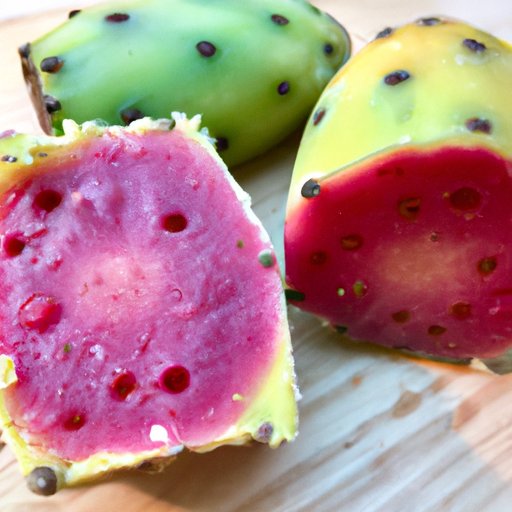Introduction
Cactus fruit, also known as prickly pear or tuna, is a sweet and juicy edible fruit that grows on many varieties of cacti. It is rich in vitamins and minerals, and may offer a range of health benefits including improved digestion and weight loss. In this article, we’ll explore how to select, prepare, and enjoy cactus fruit in a variety of recipes.

Types of Cactus Fruits Available
There are several different types of cactus fruits available. The most common type is called the prickly pear. This type of cactus fruit has a thick outer skin with small spines or thorns. Other types of cactus fruits include the dragon fruit, which has a bright pink or purple skin and white flesh, and the pitaya, which has a bright red or yellow skin and black seeds.
When selecting cactus fruits, look for those that are firm, plump, and free of blemishes or bruises. Avoid any that have soft spots or wrinkles, as these indicate they may be overripe. If you’re purchasing cactus fruits online or at a grocery store, be sure to read the label to ensure the product is organic and pesticide-free.
Preparing Cactus Fruit for Consumption
Before consuming cactus fruit, it’s important to clean and remove the spines from the outside of the fruit. To do this, hold the fruit firmly and use a sharp knife to carefully cut off the top and bottom of the fruit. Then, slice the sides off the fruit, taking care to avoid the spines. Once all the spines have been removed, rinse the fruit in cold water and pat dry.
Once the cactus fruit is cleaned, it can be cut up and prepared for eating. To do this, cut the fruit in half lengthwise and scoop out the pulp using a spoon. You can then cut the pulp into cubes or slices, depending on your preference.

Adding Cactus Fruit to Salads and Smoothies
Cactus fruit can be added to salads to give them a sweet and tart flavor. To do this, combine cubed or sliced cactus fruit with your favorite salad greens, such as spinach or kale. Add some diced avocado and a few tablespoons of olive oil and balsamic vinegar, and season with salt and pepper to taste.
Cactus fruit can also be used to make delicious smoothies. To do this, combine ½ cup of cactus fruit pulp, ½ cup of Greek yogurt, 1 banana, 1 tablespoon of honey, and ½ cup of almond milk in a blender. Blend until smooth, then pour into glasses and enjoy.
Making a Delicious Cactus Fruit Salsa
Cactus fruit salsa is a delicious and easy way to enjoy the unique flavor of cactus fruit. To make it, combine 1 cup of cubed cactus fruit, 1 diced jalapeno pepper, 2 tablespoons of diced red onion, 2 tablespoons of chopped fresh cilantro, 1 teaspoon of lime juice, and a pinch of sea salt in a bowl. Mix everything together and refrigerate for an hour before serving.

Roasting or Grilling Cactus Fruit
Roasting or grilling cactus fruit is a great way to bring out its natural sweetness. To roast or grill cactus fruit, preheat your oven to 375°F or preheat your grill to medium-high heat. Cut the cactus fruit into wedges and brush with olive oil. Place the wedges in a baking dish or on the grill and cook for 10-15 minutes until tender. For added flavor, sprinkle with a pinch of sea salt and freshly ground black pepper.
Enjoying Cactus Fruit in Traditional Dishes
Cactus fruit can also be incorporated into traditional dishes for a unique twist. For example, you can add cubed or sliced cactus fruit to tacos, burritos, enchiladas, and other Mexican dishes. Or, try adding cactus fruit to soups, stews, and chilies. You can also use cactus fruit to make jams, jellies, and preserves.
Conclusion
Cactus fruit is a tasty and nutritious addition to any diet. It is high in vitamins and minerals, and may offer a range of health benefits. From salads and smoothies to salsas and traditional dishes, there are many ways to enjoy cactus fruit.
(Note: Is this article not meeting your expectations? Do you have knowledge or insights to share? Unlock new opportunities and expand your reach by joining our authors team. Click Registration to join us and share your expertise with our readers.)
